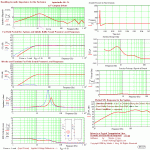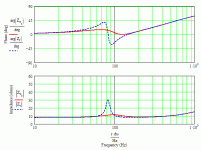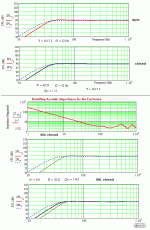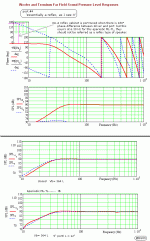Hello all !
I got a pair of 12" drivers with these specs:
Fs 30 Hz
Re 7.7 ohm
Qms 4.27
Qes 0.96
Qts 0.78
Vas 181 ltr.
Sd 0.049 m2
Mms 52 gr
Any care to help me on the dimentions for a (mass-loaded) TL ?
Tuned (very) low, as I intent to make a four-way
(sort-of like the Rogers Monitor / Pro 9 / Cambridge Audio R50)
Cheers, and thanks in advance !
Empee
I got a pair of 12" drivers with these specs:
Fs 30 Hz
Re 7.7 ohm
Qms 4.27
Qes 0.96
Qts 0.78
Vas 181 ltr.
Sd 0.049 m2
Mms 52 gr
Any care to help me on the dimentions for a (mass-loaded) TL ?
Tuned (very) low, as I intent to make a four-way
(sort-of like the Rogers Monitor / Pro 9 / Cambridge Audio R50)
Cheers, and thanks in advance !
Empee
Hi,
Go for an Aperiodic ML-TL, tuned at 12-13 Hz :Internal dimensions: L48"xW14"xD16.5"
Port=4"dia: L=12", port stuffed with 22 (g) and the entire enclosure with 2.2 kg wool.
Driver at 32” and port at 42" from top, internal dimensions.
Se picture: 1(1)
b
1(1)
Go for an Aperiodic ML-TL, tuned at 12-13 Hz :Internal dimensions: L48"xW14"xD16.5"
Port=4"dia: L=12", port stuffed with 22 (g) and the entire enclosure with 2.2 kg wool.
Driver at 32” and port at 42" from top, internal dimensions.
Se picture: 1(1)
b
1(1)
Attachments
Hi !
Thank you both, for your calculation and comment.
But regarding the outcome.... waaah !!
a cab (essentially a reflex, as I see it) of 181 liter is BIG, man !!
I thought TL's could have a high Qts
What would happen if one was to use such a high Qts in a TL,
boominess or just the other way around, lean bass ?
Cheers !
Empee
Thank you both, for your calculation and comment.
But regarding the outcome.... waaah !!
a cab (essentially a reflex, as I see it) of 181 liter is BIG, man !!
I thought TL's could have a high Qts
What would happen if one was to use such a high Qts in a TL,
boominess or just the other way around, lean bass ?
Cheers !
Empee
Hi T.C. !
that's strange, on the t-linespeakers.org there is an article called "Martin J King for Dummies" in wich he states;
also in this text it says;
Is there such a thing as a Qtc for transmissionlines as it is with sealed cabinets ?
Cheers,
Empee
Cheers,
Empee
that's strange, on the t-linespeakers.org there is an article called "Martin J King for Dummies" in wich he states;
Original text by MJK
Qts -- I use a Qts value of 0.35 to distinguish between high and low Qts. You might have another definition. Drivers with a high Qts perform better than driver with low Qts in a quarter wave design. On the other hand, the lower Qts driver seems to require less volume, thereby resulting in a smaller enclosure. Low Qts drivers have a roll off that starts earlier than high Qts drivers, and drivers with a moderate or high Qts will often result in the best low end performance. But this is also a matter of taste and preferences. "Good sound" is defined by you only. The output from the opening is broader with high Qts drivers, compared to low Qts drivers that have a narrower output from the opening. Drivers with a Qts lower than 0.30 seem to be difficult to control in a TL.
also in this text it says;
choose a speaker/subwoofer with a Qts between 0.4 – 0.6, and an fs of reasonable depth.
Is there such a thing as a Qtc for transmissionlines as it is with sealed cabinets ?
Cheers,
Empee
Cheers,
Empee
Empee said:
a cab (essentially a reflex, as I see it) of 181 liter is BIG, man !!
I thought TL's could have a high Qts
What would happen if one was to use such a high Qts in a TL,
boominess or just the other way around, lean bass ?
Cheers !
Empee
TLs work extremely well with high Q drivers, yielding a lower f3 for a given Fp, but when you have both a high Q and high Vas they require a lot of Vb. Indeed, my default alignment for this high a Q driver is a max flat impedance TL (38.46 Hz Fp) which weighs in at a plump 292 L, though it does have enough more gain to probably not need any BSC if otherwise required and is much better damped than a 181 L MLTL/whatever. Cutting the Vb in half to 146 L raises F3 from 40 to 50 Hz, so no joy there unless it's an acceptable trade-off.
Bottom line, for a given Qts, F3, the lower Vas is, the smaller the TL, etc., Vb is, ditto Vas Vs Qts, though F3 rises at a rapid rate as Vb shrinks.
GM
Empee said:
Is there such a thing as a Qtc for transmissionlines as it is with sealed cabinets ?
Other than the max flat impedance I referenced, I don't recall anything specific, though you can match a TL's roll off slope to known Qtc values down to where it finally rolls off at a vented alignment's 4th order. IOW, If I tune your driver to Fs with an acoustically tiny CSA = Sd and stuff it heavily it will theoretically have a critically damped 0.5 Qtc down to Fs where it will start transitioning to 4th order somewhere below 10 Hz along with a nominally flat acoustic and impedance phase. This is 'ideal' compression horn performance, i.e. this is as good as it gets as far as it goes. The trade-off is an unacceptably high ~100 Hz F3 due to its tiny acoustic size plus stuffing being used to mass load (damp) the driver into a much lower effective Fs, Qts.
GM
cheers T.C,
Hey T.C. & G.M. !
Thank you very much for your input, and no, I'm not trying to shoehorn my driver into something that won't work. That's the whole reaseon for me asking your knowledge !
As G.M. stated, - and G.M.; thank you very much for that ! - it's the high Vas that does it (or doesn't do it, actually)
I see now a classic TL won't work, and thinking WAF, the max-flat variation won't either, so I still don't know what to do with this
driver.
However, I still do not understand how this thing could have worked so well in the original 80 ltr. closed cabinet Philips orginally put this driver in.
check this speakercabinet
Thank you very much for your input, and no, I'm not trying to shoehorn my driver into something that won't work. That's the whole reaseon for me asking your knowledge !
As G.M. stated, - and G.M.; thank you very much for that ! - it's the high Vas that does it (or doesn't do it, actually)
I see now a classic TL won't work, and thinking WAF, the max-flat variation won't either, so I still don't know what to do with this
driver.
However, I still do not understand how this thing could have worked so well in the original 80 ltr. closed cabinet Philips orginally put this driver in.
check this speakercabinet
You're welcome!
Hmm, as I noted, a classic TL does work, it just won't be small due to the driver's specs.
I can only guess since I don't know how it performed or even if we share a common definition of what constitutes a good performing LF BW speaker, but from a technical POV it's a rather poor performing one due to having a ~1.235 Qtc.
That said, if there's no sealing gasket on the rear cover, then it may leak enough to bleed off enough of its peaking BW to sound 'tight' in-room. Altec among others did this to keep their consumer speakers a semi-manageable size considering the driver's specs and the 'bean counters' happy by saving some $$$ in materials/parts/labor, so an option for you if you want a small cab, though it will mean a higher F3 than the larger cabs. Not many 'free lunches' in speaker design.
GM
Hmm, as I noted, a classic TL does work, it just won't be small due to the driver's specs.
I can only guess since I don't know how it performed or even if we share a common definition of what constitutes a good performing LF BW speaker, but from a technical POV it's a rather poor performing one due to having a ~1.235 Qtc.
That said, if there's no sealing gasket on the rear cover, then it may leak enough to bleed off enough of its peaking BW to sound 'tight' in-room. Altec among others did this to keep their consumer speakers a semi-manageable size considering the driver's specs and the 'bean counters' happy by saving some $$$ in materials/parts/labor, so an option for you if you want a small cab, though it will mean a higher F3 than the larger cabs. Not many 'free lunches' in speaker design.
GM
l did think to suggest aperoidic loading, but no l think the driver is wrong for this type of enclosure otherwise GM might have mentioned it too, as he says there's no free lunch in speaker design just like marriage, its all a compromise, which one it is is up to you
cheers T.C. :
:
cheers T.C.
Actually....... other than an 'ideal' BLH, the max flat impedance TL I suggested is the only true aperiodic design if the proper amount of stuffing is used AFAIK, i.e. its Fs impedance peak is ~completely damped (flattened), resulting in a nominally flat phase response until any inductance shifts it. Any other so-called 'aperiodic' tuning is only capable of partially damping it and as high as the Philips cab is tuned, none at all, so only acts as a pressure release valve.
GM
A sim of a different driver:
GM
A sim of a different driver:
Attachments
I still do not understand how this thing could have worked so well in the original 80 ltr. closed cabinet Philips orginally put this driver in.
IMO, I remember this driver sounded good if in a about 80 L closed box and if placed away from any wall as the system Q is peaking at a frequency low enough not colouring the mid-bass too much, See pictures 1(2).
l did think to suggest aperiodic loading, but no l think the driver is wrong for this type of enclosure otherwise GM might have mentioned it too, as he says there's no free lunch in speaker design just like marriage, its all a compromise, which one it is up to you…
I don’t agree with this conclusion, my simulations was based on the On Topic question whether mass-loaded TL could be designed or not, but I didn’t answer if it’s worth the effort because it’s another question. FWIW, In that case my answer would be no, because if the port is blocked there’s virtually no performance difference if compared to the box closed. See picture 1(2).
Increasing the box volume to the double of Vas and a slightly larger port stuffed with half the density of stuffing would be different if the goal is to come very close to an IB performance,but max inband excursion based SPL may suffer. See picture 2(2).
Actually....... other than an 'ideal' BLH, the max flat impedance TL I suggested is the only true aperiodic design if the proper amount of stuffing is used AFAIK, i.e. its Fs impedance peak is ~completely damped (flattened), resulting in a nominally flat phase response until any inductance shifts it. Any other so-called 'aperiodic' tuning is only capable of partially damping it and as high as the Philips cab is tuned, none at all, so only acts as a pressure release valve.
Of course
b
1(2)
Attachments
 if l were you l'd use the bass driver as a boat anchor and get one that is more usable for your purposes
if l were you l'd use the bass driver as a boat anchor and get one that is more usable for your purposescheersT.C.

qwad said:[B...use the bass driver as a boat anchor...[/B]
Hehehehe
Thanks for the suggestion, but my boat is firmly secured by a Bose cabinet I got for free

(did you know BOSE stands for Buy Other Sound Equipment ?)
Anyway; thank you all very, very much for all the information, quite informative & educational
and no, I do NOT mind this thread becomming a "what to do with these drivers"-discussion
So,
would it be an idea to build a (quick'n dirty) box of 80ltr.,
stuff is in order to make it look bigger to the driver (I read you can make a 20% increase in
appearent volume ?) and than, to top it off, experiment with an aperiodic vent ?
I understand the no-free-lunch-thing, but perhaps I could bring the Qtc back from a huge 1,25 to a big 1 ?
Cheers y'all !!
Empee
Empee said:...and than, to top it off, experiment with an aperiodic vent ?
Sorry !!
re-read your posts and now understand the aperiodic thing won't work in a cab of 80ltr.
So just stuff it basically. How much stuffing will I need ?
Cheers !
Empee
re-read your posts and now understand the aperiodic thing won't work in a cab of 80ltr.
It will work but nothing gained performance–wise, but if you apply Qm damping, you can lower the driver Qts, trading off the midband sensitivity a bit, then things could appear quite differently.
http://www.diyaudio.com/forums/showthread.php?postid=976183#post976183
So just stuff it basically. How much stuffing will I need ?
If a closed 80 L box: Req. 1.5kg (medium) to 2.2 kg (heavily) stuffing but can be lowered if driver is Qm damped with no stuffing in a port which then can be included.
b
If a closed 80 L box: Req. 1.5kg (medium) to 2.2 kg (heavily) stuffing
Sorry,this req. was for a 180 L box, not if 80 L.
If a closed 80 L box the req. should be: 0.5kg (medium) to 0.75 kg (heavily) stuffing and 0.5 kg or less if a Qm damped driver is used.
b
- Status
- This old topic is closed. If you want to reopen this topic, contact a moderator using the "Report Post" button.
- Home
- Loudspeakers
- Multi-Way
- Question for TL-wizzards



